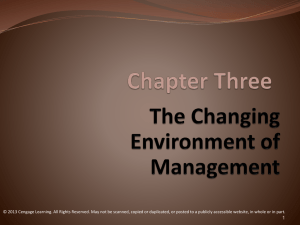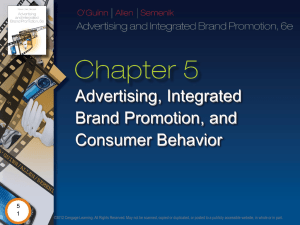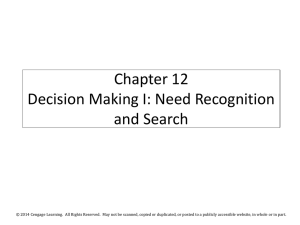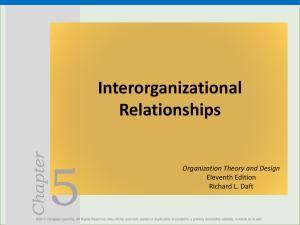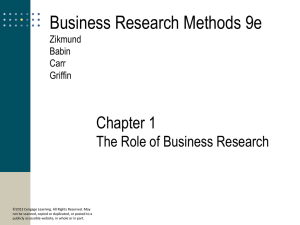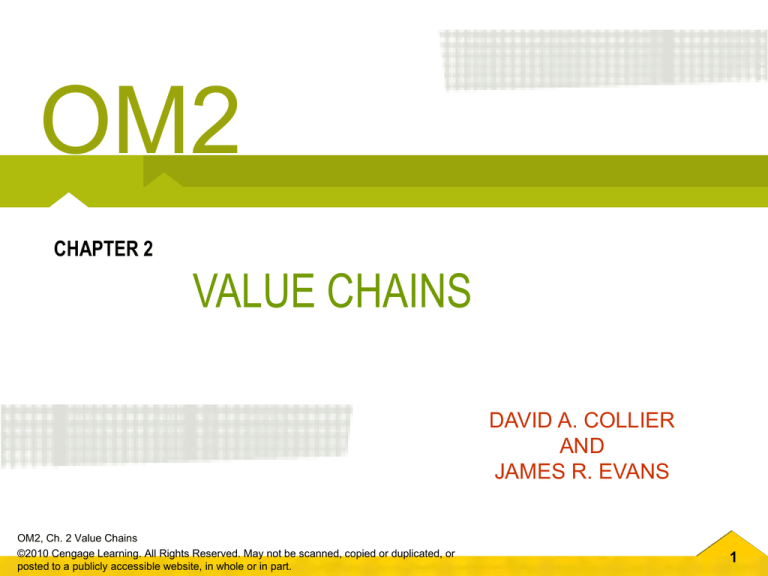
OM2
CHAPTER 2
VALUE CHAINS
DAVID A. COLLIER
AND
JAMES R. EVANS
OM2, Ch. 2 Value Chains
©2010 Cengage Learning. All Rights Reserved. May not be scanned, copied or duplicated, or
posted to a publicly accessible website, in whole or in part.
1
Chapter 2 Learning Outcomes
learning outcomes
LO1 Explain the concept of value and how it can be
increased.
LO2 Describe a value chain and the two major
perspectives that characterize it.
LO3 Describe a supply chain and how it differs from a
value chain.
LO4 Discuss key value chain decisions.
LO5 Explain offshoring and the key issues associated
with it.
LO6 Identify important issues associated with value
chains in a global business environment.
OM2, Ch. 2 Value Chains
©2010 Cengage Learning. All Rights Reserved. May not be scanned, copied or duplicated, or
posted to a publicly accessible website, in whole or in part.
2
Chapter 2 Value Chains
t a time when more than 98% of all shoes sold in the United States are
made in other countries, Allen-Edmonds Shoe Corp. is a lonely holdout
against offshoring. Moving to China could have saved as much as 60
percent. However, John Stollenwerk, Chief Executive, will not compromise on quality,
and believes that Allen-Edmonds can make better shoes, and serve customers faster,
in the United States. An experiment in producing one model in Portugal resulted in
lining that wasn’t quite right and stitching that wasn’t as fine. Stollenwerk noted
“We could take out a few stitches and you’d never notice it – and then we could take
out a few more. Pretty soon you’ve cheapened the product, and you don’t stand for
what you’re about.” Instead, Allen-Edmonds invested more than $1 million to
completely overhaul its manufacturing process into a leaner and more efficient
system that could reduce 5 percent off the cost of each pair of shoes. One year
after implementing its new production processes, productivity was up 30 percent,
damages were down 14 percent, and order fulfillment neared 100 percent, enabling
the company to serve customers better than ever.
What is your opinion of companies that move operations
to other countries with cheaper labor rates? Should governments influence or
legislate such decisions?
What do you think?
OM2, Ch. 2 Value Chains
©2010 Cengage Learning. All Rights Reserved. May not be scanned, copied or duplicated, or
posted to a publicly accessible website, in whole or in part.
3
Chapter 2 Value Chains
Value Chains
• The underlying purpose of every organization
is to provide value to its customer and
stakeholders.
• Value is the perception of the benefits
associated with a good, service, or bundle of
goods and services (i.e., the customer benefit
package) in relation to what buyers are
willing to pay for them.
OM2, Ch. 2 Value Chains
©2010 Cengage Learning. All Rights Reserved. May not be scanned, copied or duplicated, or
posted to a publicly accessible website, in whole or in part.
4
Chapter 2 Value Chains
Value Chains
• The decision to purchase a good or service,
or a customer benefit package, is based on
an assessment by the customer of the
perceived benefits in relation to its price.
• The customer's cumulative judgment of the
perceived benefits leads to either satisfaction
or dissatisfaction.
OM2, Ch. 2 Value Chains
©2010 Cengage Learning. All Rights Reserved. May not be scanned, copied or duplicated, or
posted to a publicly accessible website, in whole or in part.
5
Chapter 2 Value Chains
One of the simplest functional forms of value is:
Value = Perceived benefits/Price (cost) to the customer
If the value ratio is high, the good or service is perceived
favorably by customers, and the organization providing it is
more likely to be successful. To increase value, an organization
must:
(a) increase perceived benefits while holding price or cost
constant,
(b) increase perceived benefits while reducing price or cost, or
(c) decrease price or cost while holding perceived benefits
constant.
OM2, Ch. 2 Value Chains
©2010 Cengage Learning. All Rights Reserved. May not be scanned, copied or duplicated, or
posted to a publicly accessible website, in whole or in part.
6
Chapter 2 Value Chains
Value Chains
• A value chain is a network of facilities and
processes that describes the flow of goods,
services, information, and financial transactions
from suppliers through the facilities and
processes that create goods and services and
deliver them to customer.
• A value chain is a “cradle-to-grave” model of
the operations function (see Exhibit 2.1).
OM2, Ch. 2 Value Chains
©2010 Cengage Learning. All Rights Reserved. May not be scanned, copied or duplicated, or
posted to a publicly accessible website, in whole or in part.
7
Chapter 2 Value Chains
Value Chains
• The value chain begins with suppliers.
Suppliers might be distributors, employment
agencies, dealers, financing and leasing agents,
information and Internet companies, field
maintenance and repair services, architectural
and engineering design firms, and contractors,
as well as manufacturers of materials and
components.
OM2, Ch. 2 Value Chains
©2010 Cengage Learning. All Rights Reserved. May not be scanned, copied or duplicated, or
posted to a publicly accessible website, in whole or in part.
8
Exhibit 2.1
OM2, Ch. 2 Value Chains
©2010 Cengage Learning. All Rights Reserved. May not be scanned, copied or duplicated, or
posted to a publicly accessible website, in whole or in part.
The Value Chain
9
Chapter 2 Value Chains
Value Chains
• The inputs suppliers provide might be physical
goods such as:
automobile engines or microprocessors
provided to an assembly plant;
meat, fish, and vegetables provided to a
restaurant;
trained employees provided to organizations
by universities and technical schools; or
information such as computer specifications
or a medical diagnosis.
OM2, Ch. 2 Value Chains
©2010 Cengage Learning. All Rights Reserved. May not be scanned, copied or duplicated, or
posted to a publicly accessible website, in whole or in part.
10
Chapter 2 Value Chains
Value Chains
• Inputs are transformed into value-added goods
and services through processes or networks of
work activities, which are supported by such
resources as land, labor, money, and
information.
• The value chain outputs—goods and services—
are delivered or provided to customers and
targeted market segments.
OM2, Ch. 2 Value Chains
©2010 Cengage Learning. All Rights Reserved. May not be scanned, copied or duplicated, or
posted to a publicly accessible website, in whole or in part.
11
Exhibit 2.2
Examples of Goods-Producing and Service-Providing Value Chains
(slide 1)
OM2, Ch. 2 Value Chains
©2010 Cengage Learning. All Rights Reserved. May not be scanned, copied or duplicated, or
posted to a publicly accessible website, in whole or in part.
12
Exhibit 2.2
Examples of Goods-Producing and Service-Providing Value Chains
(slide 2)
OM2, Ch. 2 Value Chains
©2010 Cengage Learning. All Rights Reserved. May not be scanned, copied or duplicated, or
posted to a publicly accessible website, in whole or in part.
13
Exhibit 2.3
Pre- and Postservice View of the Value Chain
OM2, Ch. 2 Value Chains
©2010 Cengage Learning. All Rights Reserved. May not be scanned, copied or duplicated, or
posted to a publicly accessible website, in whole or in part.
14
Chapter 2 Value Chains
A Service View of a Business
•
Nestle once defined its business from a physical good
viewpoint as "selling coffee machines." Using service
management thinking, they redefined their business from
a service perspective where the coffee machine is more
of a peripheral good.
•
They decided to lease coffee machines and provide daily
replenishment of the coffee and maintenance of the
machine for a contracted service fee. This "primary
leasing service" was offered to organizations that sold
more than 50 cups of coffee per day.
OM2, Ch. 2 Value Chains
©2010 Cengage Learning. All Rights Reserved. May not be scanned, copied or duplicated, or
posted to a publicly accessible website, in whole or in part.
15
Chapter 2 Value Chains
A Service View of a Business
• The results were greatly increased Nestle
coffee sales, new revenue opportunities, and
much stronger profits.
• Nestle's service vision of their business
required a completely new service and
logistical value chain capability.
OM2, Ch. 2 Value Chains
©2010 Cengage Learning. All Rights Reserved. May not be scanned, copied or duplicated, or
posted to a publicly accessible website, in whole or in part.
16
Chapter 2 Value Chains
Buhrke Industries, Inc. Value Chain
•
Buhrke Industries Inc., located in Arlington Heights,
Illinois, provides stamped metal parts to many
industries, including automotive, appliance, computer,
electronics, hardware, housewares, power tools,
medical, and telecommunications.
•
Buhrke’s objective is to be a customer’s best total-value
producer with on-time delivery, fewer rejects, and
high-quality stampings. However, the company goes
beyond manufacturing goods; it prides itself in
providing the best service available as part of its
customer value chain.
OM2, Ch. 2 Value Chains
©2010 Cengage Learning. All Rights Reserved. May not be scanned, copied or duplicated, or
posted to a publicly accessible website, in whole or in part.
17
Exhibit 2.4
The Value Chain at Buhrke Industries
Source: Buhrke Industries company web site
OM2, Ch. 2 Value Chains
©2010 Cengage Learning. All Rights Reserved. May not be scanned, copied or duplicated, or
posted to a publicly accessible website, in whole or in part.
18
Chapter 2 Value Chains
Buhrke Industries, Inc. Value Chain
• Service is more than delivering a product
on-time. It's also partnering with customers
by providing personalized service for fast,
accurate response; customized engineering
designs to meet customer needs; preventive
maintenance systems to ensure high machine
uptime; experienced, highly trained, long-term
employees; and troubleshooting by a
knowledgeable sales staff.
OM2, Ch. 2 Value Chains
©2010 Cengage Learning. All Rights Reserved. May not be scanned, copied or duplicated, or
posted to a publicly accessible website, in whole or in part.
19
Chapter 2 Value Chains
Value and Supply Chains
A supply chain is the portion of the value chain
that focuses primarily on the physical movement
of goods and materials, and supporting flows of
information and financial transactions through the
supply, production, and distribution processes.
Many organizations use the terms “value chain”
and “supply chain” interchangeably; however, we
differentiate these two terms in this book.
OM2, Ch. 2 Value Chains
©2010 Cengage Learning. All Rights Reserved. May not be scanned, copied or duplicated, or
posted to a publicly accessible website, in whole or in part.
20
Chapter 2 Value Chains
Value and Supply Chains
A value chain is broader in scope than a supply
chain, and encompasses all pre- and postproduction services (see Exhibit 2.3) to create and
deliver the entire customer benefit package.
A value chain views an organization from the
customer's perspective—the integration of goods
and services to create value—while a supply
chain is more internally-focused on the creation
of physical goods.
OM2, Ch. 2 Value Chains
©2010 Cengage Learning. All Rights Reserved. May not be scanned, copied or duplicated, or
posted to a publicly accessible website, in whole or in part.
21
Exhibit 2.3
Pre- and Postservice View of the Value Chain
OM2, Ch. 2 Value Chains
©2010 Cengage Learning. All Rights Reserved. May not be scanned, copied or duplicated, or
posted to a publicly accessible website, in whole or in part.
22
Chapter 2 Value Chains
Procter & Gamble’s Supply Chain Structure
A model of a supply chain developed by Procter &
Gamble—P&G’s “Ultimate Supply System”—is shown
in Exhibit 2.5.
The supply chain focus is on understanding the
impact of tightly coupling supply chain partners to
integrate information, physical material, product
flow, and financial activities to increase sales,
reduce costs, increase cash flow, and provide the
right product at the right time at the right price to
customers.
OM2, Ch. 2 Value Chains
©2010 Cengage Learning. All Rights Reserved. May not be scanned, copied or duplicated, or
posted to a publicly accessible website, in whole or in part.
23
Exhibit 2.5
Procter & Gamble’s Conceptual Model of a Supply Chain
for Paper Products
Source: Wegryn, Glenn W., and Siprelle, Andrew J.,
“Combined Use of Optimization and Simulation Technologies to design an Optional Logistics Network,”
http://www.simulationdynamics.com/PDFs/Papers/CLM%20P&G%Opt&Sim.pdf
OM2, Ch. 2 Value Chains
©2010 Cengage Learning. All Rights Reserved. May not be scanned, copied or duplicated, or
posted to a publicly accessible website, in whole or in part.
24
Chapter 2 Value Chains
Value Chain Design and Management
Outsourcing is the opposite of vertical
integration in the sense that the
organization is shedding (not acquiring) a
part of its organization.
OM2, Ch. 2 Value Chains
©2010 Cengage Learning. All Rights Reserved. May not be scanned, copied or duplicated, or
posted to a publicly accessible website, in whole or in part.
25
Chapter 2 Value Chains
Value Chain Design and Management
• Vertical integration refers to the process of
acquiring and consolidating elements of a value
chain to achieve more control.
• Outsourcing is the process of having suppliers
provide goods and services that were
previously provided internally.
OM2, Ch. 2 Value Chains
©2010 Cengage Learning. All Rights Reserved. May not be scanned, copied or duplicated, or
posted to a publicly accessible website, in whole or in part.
26
Chapter 2 Value Chains
Value Chain Design and Management
• Backward integration refers to acquiring
capabilities at the front-end of the supply
chain (for instance, suppliers), while forward
integration refers to acquiring capabilities
toward the back-end of the supply chain (for
instance, distribution or even customers).
• Companies must decide whether to integrate
backward (acquiring suppliers) or forward
(acquiring distributors), or both.
OM2, Ch. 2 Value Chains
©2010 Cengage Learning. All Rights Reserved. May not be scanned, copied or duplicated, or
posted to a publicly accessible website, in whole or in part.
27
Chapter 2 Value Chains
Automobile Suppliers – Vanish or Rebound?
Clips & Clamps Industries located in Plymouth, Michigan has been
selling metal brackets for decades to the big three Detroit
automobile manufacturers—General Motors, Ford, and Chrysler.
But a few years ago, the firm decided it must become a tier-one
supplier to Toyota, Honda, and Nissan if it was to survive the
global economic downturn. Mr. Aznavirian, President and coowner, said “You can’t sit around waiting for the Big Three to
come back.” Mr. Aznavirian lead efforts to gain work from the
Japanese firms by reducing equipment downtime, producing less
scrap, and becoming a more efficient part of the global supply
chain. --- Mr. Craig Fitzgerald, a consultant, noted that “more than
half of North America’s 1,200 small auto suppliers will vanish into
bankruptcies, mergers, and liquidations…. But some like Clips
and Clamps will reinvent themselves and rebound.”
OM2, Ch. 2 Value Chains
©2010 Cengage Learning. All Rights Reserved. May not be scanned, copied or duplicated, or
posted to a publicly accessible website, in whole or in part.
28
Chapter 2 Value Chains
The U.S. has experienced three waves of outsourcing:
• The first wave involved the exodus of goodsproducing jobs from the U.S. in many industries
several decades ago. Gibson Guitars, for example,
produces its Epiphone line in Korea.
• The second wave involved simple service work,
such as standard credit card processing, billing and
other forms of transaction processing, keying
information into computers, and writing simple
software programs. Accenture, for example, does
much of its bookkeeping operations in Costa Rica.
OM2, Ch. 2 Value Chains
©2010 Cengage Learning. All Rights Reserved. May not be scanned, copied or duplicated, or
posted to a publicly accessible website, in whole or in part.
29
Chapter 2 Value Chains
The U.S. has experienced three waves of outsourcing:
• The third, and current wave, involves skilled
knowledge work, such as engineering design,
graphic artists, architectural plans, call center
customer service representatives, and computer
chip design. For example, Massachusetts General
Hospital uses radiologists located in Bangalore,
India, to interpret CT scans.
OM2, Ch. 2 Value Chains
©2010 Cengage Learning. All Rights Reserved. May not be scanned, copied or duplicated, or
posted to a publicly accessible website, in whole or in part.
30
Chapter 2 Value Chains
Solved Problem
Suppose that a manufacturer needs to produce a
custom aluminum housing for a special customer
order. Because it currently does not have the
equipment necessary to make the housing, it would
have to acquire machines and tooling at a fixed cost
(net of salvage value after the project is completed)
of $250,000. The variable cost of production is
estimated to be $20 per unit. The company can
outsource the housing to a metal fabricator at a cost
of $35 per unit. The customer order is for 12,000
units. What should they do?
OM2, Ch. 2 Value Chains
©2010 Cengage Learning. All Rights Reserved. May not be scanned, copied or duplicated, or
posted to a publicly accessible website, in whole or in part.
31
Chapter 2 Value Chains
Solution
VC1 = Variable cost/unit if produced = $20
VC2 = Variable cost/unit if outsourced = $35
FC = fixed costs associated with producing the part = $250,000
Q = quantity produced
Using Equation 2.1 we obtain:
Q = 250,000/($35 - $20) = 16,667
In this case, because the customer order is for only 12,000
units, which is less than the break-even point, the least cost
decision is to outsource the component.
OM2, Ch. 2 Value Chains
©2010 Cengage Learning. All Rights Reserved. May not be scanned, copied or duplicated, or
posted to a publicly accessible website, in whole or in part.
32
Chapter 2 Value Chains
Value chain integration is the process of
managing information, physical goods, and
services to ensure their availability at the
right place, at the right time, at the right
cost, at the right quantity, and with the
highest attention to quality.
OM2, Ch. 2 Value Chains
©2010 Cengage Learning. All Rights Reserved. May not be scanned, copied or duplicated, or
posted to a publicly accessible website, in whole or in part.
33
Chapter 2 Value Chains
Value chain integration in services—where value is in
the form of low prices, convenience, and access to special
time-sensitive deals and travel packages—takes many
forms. Examples include:
• Third-party integrators for the leisure and travel industry
value chains include Orbitz, Expedia, Priceline, and
Travelocity.
• Many financial services use information networks provided
by third-party information technology integrators, such as
AT&T, Sprint, IBM, and Verizon, to coordinate their value
chains.
• Hospitals also use third-party integrators for both their
information and physical goods, such as managing patient
billing and hospital inventories.
OM2, Ch. 2 Value Chains
©2010 Cengage Learning. All Rights Reserved. May not be scanned, copied or duplicated, or
posted to a publicly accessible website, in whole or in part.
34
Chapter 2 Value Chains
Offshoring is the building, acquiring, or
moving of process capabilities from a
domestic location to another country
location while maintaining ownership
and control.
OM2, Ch. 2 Value Chains
©2010 Cengage Learning. All Rights Reserved. May not be scanned, copied or duplicated, or
posted to a publicly accessible website, in whole or in part.
35
Extra Exhibit
Four Degrees of Offshoring Scenarios
OM2, Ch. 2 Value Chains
©2010 Cengage Learning. All Rights Reserved. May not be scanned, copied or duplicated, or
posted to a publicly accessible website, in whole or in part.
36
Chapter 2 Value Chains
According to one framework, foreign factories can
be classified into one of six categories:
1. Offshore factories established to gain access to low
wages and other ways to reduce costs, such as avoiding
trade tariffs. An offshore factory is the way most
multinational firms begin their venture into global markets
and value chains.
2. Outpost factories established primarily to gain access to
local employee skills and knowledge. Such skills and
knowledge might include software programming or call
center service management.
OM2, Ch. 2 Value Chains
©2010 Cengage Learning. All Rights Reserved. May not be scanned, copied or duplicated, or
posted to a publicly accessible website, in whole or in part.
37
Chapter 2 Value Chains
3. Server factories established to supply specific national
or regional markets.
4. Source factories, like offshore factories, established to
gain access to low cost production but also have the
expertise to design and produce a component part for the
company's global value chain.
5. Contributor factories established to serve a local
market and conduct activities like product design and
customization. Primary manufacturing, accounting,
engineering design, and marketing and sales processes
often reside at contributor factories.
6. Lead factories established to innovate and create new
processes, products, and technologies. Lead factories
must have the skills and knowledge to design and
manufacturer "the next generation of products."
OM2, Ch. 2 Value Chains
©2010 Cengage Learning. All Rights Reserved. May not be scanned, copied or duplicated, or
posted to a publicly accessible website, in whole or in part.
38
Exhibit 2.6
Example Issues to Consider When Making Offshore Decisions
OM2, Ch. 2 Value Chains
©2010 Cengage Learning. All Rights Reserved. May not be scanned, copied or duplicated, or
posted to a publicly accessible website, in whole or in part.
39
Chapter 2 Value Chains
Rocky Brands
•
•
Rocky Brands(www.rockyboots.com),
headquartered in Nelsonville, Ohio, manufactures
rugged leather shoes for hiking and camping.
•
The company began making boots in 1932 as the William
Brooks Shoe Company with an average wage rate of 28
cents per hour. In the 1960s, Rocky Shoes & Boots were
100% "Made in America." In 1960, more than 95 percent
of all shoes sold in America were made in America.
•
Timberland, Wolverine, and Rocky are popular brand
names for this shoe market segment.
OM2, Ch. 2 Value Chains
©2010 Cengage Learning. All Rights Reserved. May not be scanned, copied or duplicated, or
posted to a publicly accessible website, in whole or in part.
40
Exhibit 2.7
OM2, Ch. 2 Value Chains
©2010 Cengage Learning. All Rights Reserved. May not be scanned, copied or duplicated, or
posted to a publicly accessible website, in whole or in part.
Rocky Brands Value Chain
41
Chapter 2 Value Chains
Rocky Brands
The principal characteristics of this global value chain
are described as follows:
1. Leather is produced in Australia and then shipped
to the Dominican Republic.
2. Outsoles are purchased in China and shipped to Puerto Rico.
3. Gor-Tex fabric waterproofing materials are made in the United
States.
4. Shoe uppers are cut and stitched in the Dominican Republic,
and then shipped to Puerto Rico.
5. Final shoe assembly is done at the Puerto Rico factory.
6. The finished boots are packed and shipped to the warehouse
in Nelsonville, Ohio.
7. Customer orders are filled and shipped to individual stores and
contract customers from Nelsonville.
OM2, Ch. 2 Value Chains
©2010 Cengage Learning. All Rights Reserved. May not be scanned, copied or duplicated, or
posted to a publicly accessible website, in whole or in part.
42
Exhibit 2.7
OM2, Ch. 2 Value Chains
©2010 Cengage Learning. All Rights Reserved. May not be scanned, copied or duplicated, or
posted to a publicly accessible website, in whole or in part.
Rocky Brands Value Chain
43
Chapter 2 Value Chains
Rocky Brands Global Challenges
• Rocky profit margins are only about 2 percent
on sales of over $100 million, while Timberland
sales top $1 billion and have a 9 percent profit
margin.
• After seventy years in Nelsonville, the main
factory closed in 2002. At that time, local labor
costs were about $11 per hour without benefits,
while in Puerto Rico the hourly rate was $6; in
the Dominican Republic, $1.25; and in China, 40
cents.
OM2, Ch. 2 Value Chains
©2010 Cengage Learning. All Rights Reserved. May not be scanned, copied or duplicated, or
posted to a publicly accessible website, in whole or in part.
44
Chapter 2 Value Chains
Rocky Brands Global Challenges
• The price of boots continues to decline globally
from roughly $95 a pair to $85, and is heading
toward $75.
• The grandson of the founder of Rocky Brands
said, "We've got to get there, or we're not
going to be able to compete."
OM2, Ch. 2 Value Chains
©2010 Cengage Learning. All Rights Reserved. May not be scanned, copied or duplicated, or
posted to a publicly accessible website, in whole or in part.
45
Chapter 2 Value Chains
Issues for Managing Global Value Chains
Global supply chains face higher levels of risk
and uncertainty, requiring more inventory and
day-to-day monitoring to prevent product
shortages. Workforce disruptions, such as labor
strikes and government turmoil in foreign
countries, can create inventory shortages and
disrupting surges in orders.
OM2, Ch. 2 Value Chains
©2010 Cengage Learning. All Rights Reserved. May not be scanned, copied or duplicated, or
posted to a publicly accessible website, in whole or in part.
46
Chapter 2 Value Chains
Transportation is more complex in global value
chains. For example, tracing global shipments
normally involves more than one mode of
transportation and foreign company.
The transportation infrastructure may vary
considerably in foreign countries. The coast of
China, for example, enjoys much better
transportation, distribution, and retail
infrastructures than the vast interior of the
country.
OM2, Ch. 2 Value Chains
©2010 Cengage Learning. All Rights Reserved. May not be scanned, copied or duplicated, or
posted to a publicly accessible website, in whole or in part.
47
Chapter 2 Value Chains
Global purchasing can be a difficult process to
manage when sources of supply, regional
economies, and even governments change. Daily
changes in international currencies necessitate
careful planning and in the case of commodities,
consideration of futures contracts.
International purchasing can lead to disputes and
legal challenges relating to such things as price
fixing and quality defects.
Privatizing companies and property is another form
of major changes in global trade and regulatory
issues.
OM2, Ch. 2 Value Chains
©2010 Cengage Learning. All Rights Reserved. May not be scanned, copied or duplicated, or
posted to a publicly accessible website, in whole or in part.
48
Chapter 2 Value Chains
TuneMan Case Study
1. Draw the “bricks and mortar” process stages by which
traditional CDs are created, distributed, and sold in retail
stores. How does each player in the value chain make
money? (You can use the exhibits in the chapter to help
you identify major stages in the value chain.)
2. Draw the process stages for creating and downloading
music today. How does each player in this electronic/digital
value chain make money?
3. Compare and contrast the approaches in the previous two
questions. What’s changed? What’s new? Are there any
advantages/disadvantages of each approach?
4. Compare the role of operations in each of these value chain
structures and approaches.
OM2, Ch. 2 Value Chains
©2010 Cengage Learning. All Rights Reserved. May not be scanned, copied or duplicated, or
posted to a publicly accessible website, in whole or in part.
49



